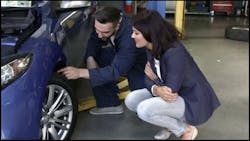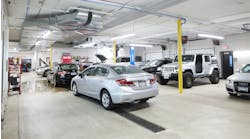The auto-repair industry has a PR problem. In 2016 AAA conducted a survey that suggested that two-thirds of drivers do not trust auto-technicians. This has been corroborated by similar surveys run in 2011 and 2021, with the latter suggesting that over a third of drivers knowingly put off necessary repairs because they do not feel like they can find a technician that they can trust.
Overcoming the knowledge gap
Anxiety around visiting the technician generally stems from car owners’ awareness of the relative lack of knowledge between themselves and the technician. Not only do people feel a deep-seated sense of embarrassment when admitting a lack of knowledge or understanding about anything, but in the context of needing a vehicle repair, a lack of technical knowledge puts customers in a vulnerable position to be overcharged by unscrupulous technicians.
This fear has been highlighted in the AAA’s survey. The most commonly cited reason for anxiety around getting your vehicle repaired was being overcharged and having no means to argue against this. Being pressured into having additional repairs and services, without fully understanding what these are and why they are being done, also ranked highly as a cause for concern.
Although a knowledge gap is the problem, education is not necessarily the solution. Many customers do not have the time nor the inclination to learn exactly why you are recommending a particular fix or service. Rather, customers want to avoid the negative consequences of their lack of knowledge, that is overpaying for unnecessary services, without having to go through the painful process of admitting their lack of understanding of the problem(s) at hand.
Multiple solutions at multiple price points
One of the reasons why auto-repair professionals have a reputation for overcharging is that our goals are often misaligned with our customers. While we are often looking to provide the best quality and most long-lasting fix, drivers generally want to just be able to get back safely on the road in as little time and for as little expense as possible.
Auto-repair professionals need to be aware that car maintenance often comes as an unexpected expense for owners. Household budgets may not stretch far enough to accommodate perfect solutions. We should therefore be willing to be flexible and practical to people’s financial constraints by, where safety allows, offering different fixes to meet different price points.
When doing this transparency is key. We need to explain to the customers both what our ideal recommendations are, as well as what the other, more affordable options are, along with the potential drawbacks. Providing customers with options shifts power onto their side, easing the feeling of helplessness that fuels anxiety around getting your car repaired.
Encouraging second opinions
Many people attribute their distrust of auto-service professionals to bad experiences in the past. Often these negative experiences will only become apparent when car owners get a second opinion on a problem, only to be recommended a much simpler and more affordable fix.
We need to do more to demonstrate transparency with customers. My team has been tackling this problem by making the first move in encouraging customers to get a second opinion on problems. Although this does involve the risk of losing potential customers to other nearby auto-shops, we hope that the long-term trust and sense of integrity that this instills in our wider market will make this worthwhile. After all, word of mouth is still king when it comes to local businesses, and since people struggle so much with finding auto-technicians that they can rely on, demonstrating that you fall into this camp can only ever be a good thing.
Working with the local community
Since people are already putting off getting repairs, we have to be proactive in turning the tide of public opinion. Everyone loves a freebie and dedicating just one day to offering free basic maintenance can carry a huge amount of favor with your local community.
This was something that we did last month, offering such free maintenance to people who had gotten vaccinated. Not only have we already had return customers from this but tying our offer into the vaccination effort got us local news coverage. This alone made the promotion worthwhile from a public relations standpoint, in addition to the trust it built in our business and offerings.
Reaching the younger generation(s)
Both the 2016 and 2021 surveys suggested that millennials carry significantly more distrust of automotive professionals than older generations. Assuming this trend continues, then we need to put particular focus on re-engaging with newer and younger drivers.
We have started reaching out to work directly with driving schools in our local area. This is still in its preliminary stage, but the aim is to try to make regular, preventative, maintenance as much as part of driving safety as wearing a seatbelt. We hope to build this bridge from both sides, combining education with further transparency on our end.
Bottom line: Customer service cannot take a backseat
Although it’s undeniable that the scale of the public’s distrust of the auto-repair industry is not entirely our fault, we need to focus on what we can do to repair it. Improving levels of customer service is the clearest way of doing this and should be seen as at least as important as staying on top of technological advancements or maximizing workshop efficiency. Tides will turn slowly, but that does not mean that it’s not worth working on it.
Information provided by United Tires




